人教版(2019)选择性必修第二册Unit 5 First Aid Using Language (I) 课件(共19张PPT)
文档属性
| 名称 | 人教版(2019)选择性必修第二册Unit 5 First Aid Using Language (I) 课件(共19张PPT) |  | |
| 格式 | pptx | ||
| 文件大小 | 5.5MB | ||
| 资源类型 | 教案 | ||
| 版本资源 | 人教版(2019) | ||
| 科目 | 英语 | ||
| 更新时间 | 2024-01-09 19:58:57 | ||
图片预览

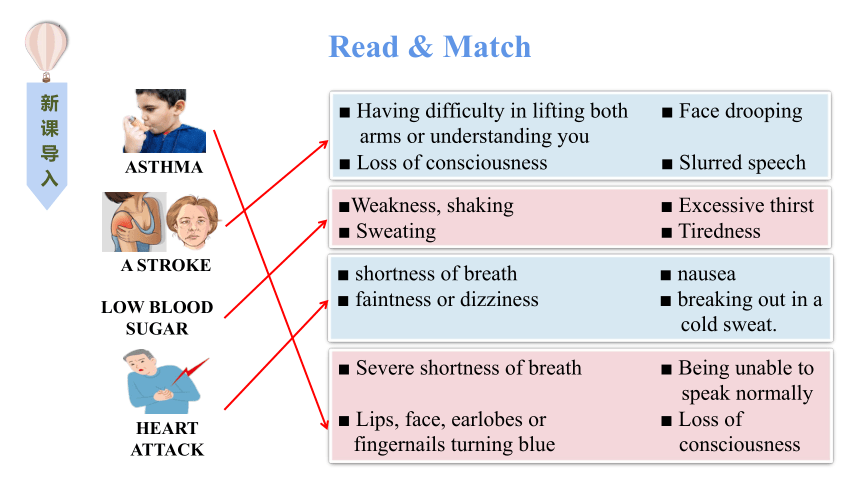
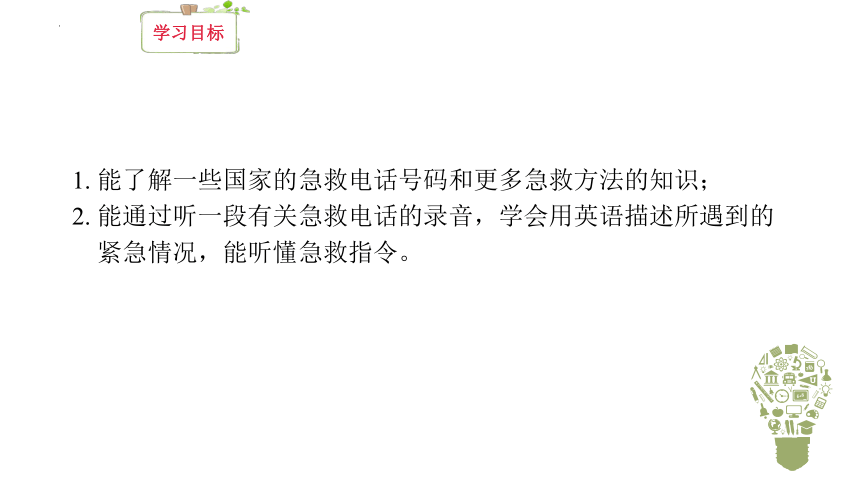
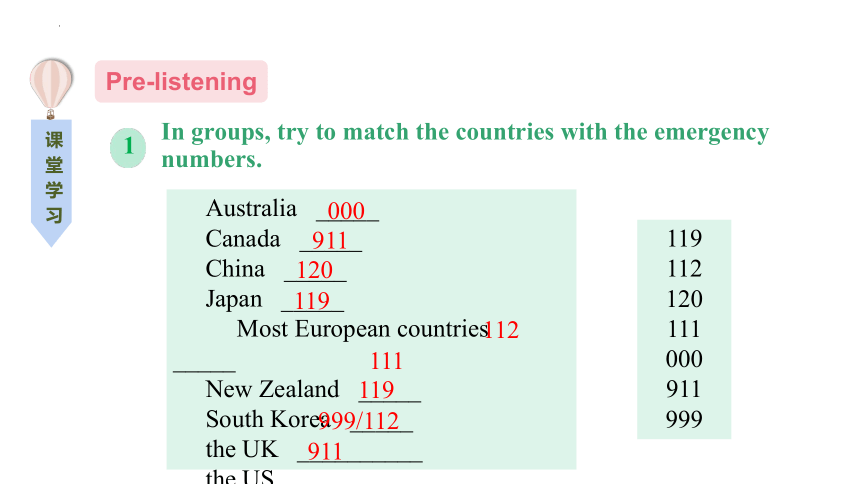
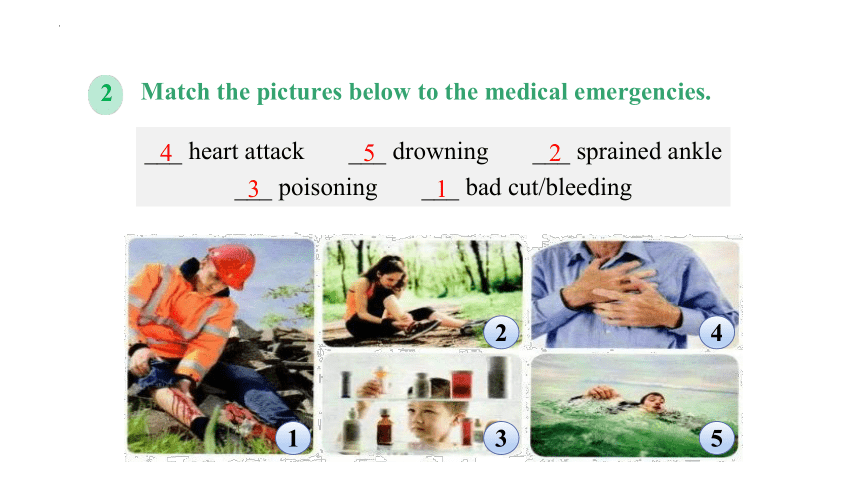

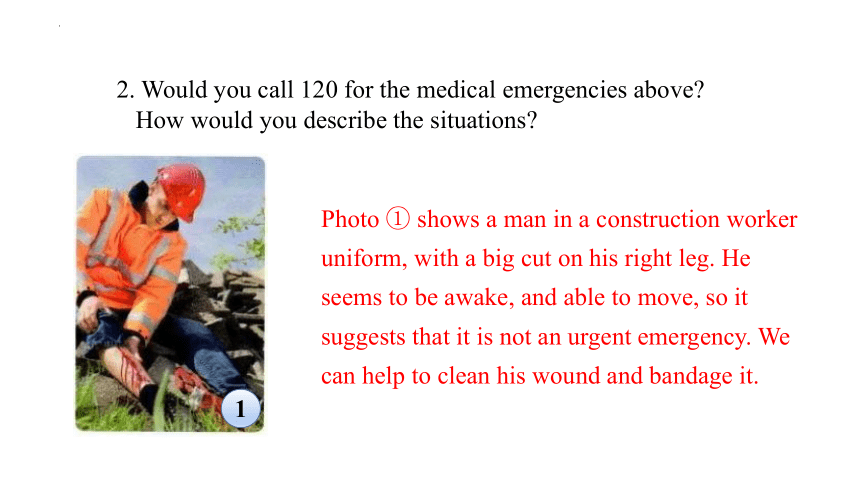
文档简介
(共19张PPT)
Unit 5
Using Language (I)
Learn to call emergency services
新 课 导 入
Read & Match
■ Severe shortness of breath ■ Being unable to
speak normally
■ Lips, face, earlobes or ■ Loss of
fingernails turning blue consciousness
■ Having difficulty in lifting both ■ Face drooping
arms or understanding you
■ Loss of consciousness ■ Slurred speech
LOW BLOOD
SUGAR
■Weakness, shaking ■ Excessive thirst
■ Sweating ■ Tiredness
■ shortness of breath ■ nausea
■ faintness or dizziness ■ breaking out in a
cold sweat.
ASTHMA
A STROKE
HEART
ATTACK
1. 能了解一些国家的急救电话号码和更多急救方法的知识;
2. 能通过听一段有关急救电话的录音,学会用英语描述所遇到的
紧急情况,能听懂急救指令。
课 堂 学 习
Pre-listening
In groups, try to match the countries with the emergency numbers.
1
Australia _____
Canada _____
China _____
Japan _____
Most European countries _____
New Zealand _____
South Korea _____
the UK __________
the US _____
119
112
120
111
000
911
999
000
911
911
120
119
119
112
111
999/112
Match the pictures below to the medical emergencies.
2
___ heart attack ___ drowning ___ sprained ankle
___ poisoning ___ bad cut/bleeding
1
2
3
4
5
4
5
2
3
1
Then discuss the questions in groups.
1. Have you ever called 120 If so, what happened
Yes, I called 120 when a neighbour suffered an accident. The ambulance came and took her to the hospital.
1
Photo ① shows a man in a construction worker uniform, with a big cut on his right leg. He seems to be awake, and able to move, so it suggests that it is not an urgent emergency. We can help to clean his wound and bandage it.
2. Would you call 120 for the medical emergencies above
How would you describe the situations
Photo ② shows a woman who is in running clothes. She is wrapping her hands around her right ankle and seems to be in some discomfort. She is sitting on the ground and I don't think she can easily walk on that foot right now.
Photo ③ shows a small child in a medicine cabinet. He is picking up a medicine. If he were to take the medicine, it would be very dangerous and potentially fatal. I would describe the situation to 120 by saying that a small child has taken my or someone else's medicine and is unresponsive.
Photo ④ shows a man grasping the left side of his chest tightly. He might be struggling to breathe and dealing with a lot of pain. He should be seen by a doctor immediately.
Photo ⑤ shows a man in water struggling to keep above it. I would describe the situation by saying there is a man far out in the water who does not seem to be able to swim. He might be drowning. Please send help!
3. What are some other medical emergencies that you would call 120 for
For someone injured in a car accident, for a stroke victim, or someone with a compound fracture.
Listen to a 999 call in England and answer the questions.
3
1. Why did the boy call 999
2. Who else was in the room with the boy and his grandfather
Because his grandfather was having a serious health problem and they needed an ambulance.
The boy's mother.
While-listening
3. How did the boy describe the old man's condition
4. Among the medical emergencies in Activity 2, which do you
think the boy's grandfather suffered from
“...his breathing has gotten really bad...I think he's dying ... His face looks funny ... he's started to breathe again ... his lips are blue... He's making strange noises... He's not breathing again... he's not breathing anymore!"
Perhaps he suffered from a heart attack.
Listen again. Number the following instructions the operator gave.
4
______ Press down, twice a second.
______ Check to see if there is food in his mouth.
______ If your mother needs a break, change places.
______ Put him on his back.
______ Remove any pillows.
______ Tell your mum to put her hand in the middle of his chest.
5
3
6
1
2
4
Follow instructions
When giving commands, people usually use the imperative.
It's simple and clear. To help the listeners follow what to do
next, they use words such as first, next, then, after that, and
finally. When listening to instructions in English, you should
● listen carefully and don't panic.
● follow the order of the instructions given to you.
● answer any questions simply and directly when asked.
Post-listening
In groups, discuss the following questions.
5
1. How did the operator keep the boy calm
2. What did the operator do to make this call a success
3. What do you think happened after the ambulance arrived
By telling him to calm down and calmly asking him questions.
She asked only the questions necessary to clearly find out the problem, and then she provided short and clear instructions as to what to do.
The doctors continued to provide CPR, took some blood pressure tests and temperature checking, while they transported him to the hospital.
The pictures below show what to do to rescue someone from drowning. In groups, discuss what is going on in each picture. Use the words given below.
6
Giving first-aid instructions for rescuing a drowning victim
lay the victim on his back check for response
check to see if he is breathing shout for help; call 120
lean his head back lift his chin
remove any grass or sand from his mouth perform CPR
perform mouth-to-mouth rescue breathing cover his mouth
blow air in push down on the centre of his chest
1
2
3
4
6
5
① Lay the victim on his back.
② Check for a response by patting his shoulders and
calling him near each side of his ears.
③ Shout for help and/or call 120.
④ Lift his chin.
⑤ Begin doing mouth-to-mouth rescue breathing:
Blow air in his mouth until his chest rises.
⑥ Perform CPR by pushing down on the centre of his
chest, and then giving him mouth-to-mouth rescue
breathing. Continue pushing on his chest and
giving him mouth-to-mouth rescue breathing until
help arrives.
In pairs, role-play an emergency call. One of you will be the friend of a drowning victim, and the other will be a telephone operator giving first-aid instructions. Use the pictures and useful expressions above to help you.
7
If you need the ambulance service:
STEP 1 Dial the emergency number and ask for an
ambulance
STEP 2 Do not panic. Keep calm and take a deep breath
STEP 3 The call operator will now ask you some
important questions --- Listen carefully and
answer all the questions simply and directly.
STEP 4 They may give you important instructions!
Follow the order.
STEP 5 DON’T hang up the phone!
STEP 6 Stay with the poorly person until the
ambulance arrives
Unit 5
Using Language (I)
Learn to call emergency services
新 课 导 入
Read & Match
■ Severe shortness of breath ■ Being unable to
speak normally
■ Lips, face, earlobes or ■ Loss of
fingernails turning blue consciousness
■ Having difficulty in lifting both ■ Face drooping
arms or understanding you
■ Loss of consciousness ■ Slurred speech
LOW BLOOD
SUGAR
■Weakness, shaking ■ Excessive thirst
■ Sweating ■ Tiredness
■ shortness of breath ■ nausea
■ faintness or dizziness ■ breaking out in a
cold sweat.
ASTHMA
A STROKE
HEART
ATTACK
1. 能了解一些国家的急救电话号码和更多急救方法的知识;
2. 能通过听一段有关急救电话的录音,学会用英语描述所遇到的
紧急情况,能听懂急救指令。
课 堂 学 习
Pre-listening
In groups, try to match the countries with the emergency numbers.
1
Australia _____
Canada _____
China _____
Japan _____
Most European countries _____
New Zealand _____
South Korea _____
the UK __________
the US _____
119
112
120
111
000
911
999
000
911
911
120
119
119
112
111
999/112
Match the pictures below to the medical emergencies.
2
___ heart attack ___ drowning ___ sprained ankle
___ poisoning ___ bad cut/bleeding
1
2
3
4
5
4
5
2
3
1
Then discuss the questions in groups.
1. Have you ever called 120 If so, what happened
Yes, I called 120 when a neighbour suffered an accident. The ambulance came and took her to the hospital.
1
Photo ① shows a man in a construction worker uniform, with a big cut on his right leg. He seems to be awake, and able to move, so it suggests that it is not an urgent emergency. We can help to clean his wound and bandage it.
2. Would you call 120 for the medical emergencies above
How would you describe the situations
Photo ② shows a woman who is in running clothes. She is wrapping her hands around her right ankle and seems to be in some discomfort. She is sitting on the ground and I don't think she can easily walk on that foot right now.
Photo ③ shows a small child in a medicine cabinet. He is picking up a medicine. If he were to take the medicine, it would be very dangerous and potentially fatal. I would describe the situation to 120 by saying that a small child has taken my or someone else's medicine and is unresponsive.
Photo ④ shows a man grasping the left side of his chest tightly. He might be struggling to breathe and dealing with a lot of pain. He should be seen by a doctor immediately.
Photo ⑤ shows a man in water struggling to keep above it. I would describe the situation by saying there is a man far out in the water who does not seem to be able to swim. He might be drowning. Please send help!
3. What are some other medical emergencies that you would call 120 for
For someone injured in a car accident, for a stroke victim, or someone with a compound fracture.
Listen to a 999 call in England and answer the questions.
3
1. Why did the boy call 999
2. Who else was in the room with the boy and his grandfather
Because his grandfather was having a serious health problem and they needed an ambulance.
The boy's mother.
While-listening
3. How did the boy describe the old man's condition
4. Among the medical emergencies in Activity 2, which do you
think the boy's grandfather suffered from
“...his breathing has gotten really bad...I think he's dying ... His face looks funny ... he's started to breathe again ... his lips are blue... He's making strange noises... He's not breathing again... he's not breathing anymore!"
Perhaps he suffered from a heart attack.
Listen again. Number the following instructions the operator gave.
4
______ Press down, twice a second.
______ Check to see if there is food in his mouth.
______ If your mother needs a break, change places.
______ Put him on his back.
______ Remove any pillows.
______ Tell your mum to put her hand in the middle of his chest.
5
3
6
1
2
4
Follow instructions
When giving commands, people usually use the imperative.
It's simple and clear. To help the listeners follow what to do
next, they use words such as first, next, then, after that, and
finally. When listening to instructions in English, you should
● listen carefully and don't panic.
● follow the order of the instructions given to you.
● answer any questions simply and directly when asked.
Post-listening
In groups, discuss the following questions.
5
1. How did the operator keep the boy calm
2. What did the operator do to make this call a success
3. What do you think happened after the ambulance arrived
By telling him to calm down and calmly asking him questions.
She asked only the questions necessary to clearly find out the problem, and then she provided short and clear instructions as to what to do.
The doctors continued to provide CPR, took some blood pressure tests and temperature checking, while they transported him to the hospital.
The pictures below show what to do to rescue someone from drowning. In groups, discuss what is going on in each picture. Use the words given below.
6
Giving first-aid instructions for rescuing a drowning victim
lay the victim on his back check for response
check to see if he is breathing shout for help; call 120
lean his head back lift his chin
remove any grass or sand from his mouth perform CPR
perform mouth-to-mouth rescue breathing cover his mouth
blow air in push down on the centre of his chest
1
2
3
4
6
5
① Lay the victim on his back.
② Check for a response by patting his shoulders and
calling him near each side of his ears.
③ Shout for help and/or call 120.
④ Lift his chin.
⑤ Begin doing mouth-to-mouth rescue breathing:
Blow air in his mouth until his chest rises.
⑥ Perform CPR by pushing down on the centre of his
chest, and then giving him mouth-to-mouth rescue
breathing. Continue pushing on his chest and
giving him mouth-to-mouth rescue breathing until
help arrives.
In pairs, role-play an emergency call. One of you will be the friend of a drowning victim, and the other will be a telephone operator giving first-aid instructions. Use the pictures and useful expressions above to help you.
7
If you need the ambulance service:
STEP 1 Dial the emergency number and ask for an
ambulance
STEP 2 Do not panic. Keep calm and take a deep breath
STEP 3 The call operator will now ask you some
important questions --- Listen carefully and
answer all the questions simply and directly.
STEP 4 They may give you important instructions!
Follow the order.
STEP 5 DON’T hang up the phone!
STEP 6 Stay with the poorly person until the
ambulance arrives
